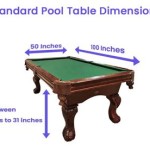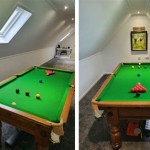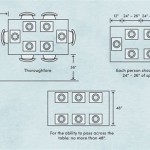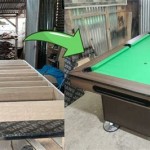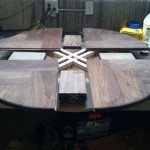Crate and Barrel Glass Tables: A Study in Design, Functionality, and Material
Crate and Barrel has established itself as a prominent retailer of modern and contemporary furniture, consistently emphasizing quality, design, and functionality. Within their expansive catalog, glass tables occupy a significant niche, offering a blend of aesthetic appeal and practical usability. Examining Crate and Barrel glass tables necessitates a comprehensive look at their design principles, material choices, and functional capabilities.
Glass tables, in general, provide a unique aesthetic, characterized by transparency and a sense of openness. This inherent characteristic makes them suitable for a variety of interior design styles, from minimalist to eclectic. The reflective properties of glass can also enhance the perception of space, making smaller rooms feel larger and brighter. Crate and Barrel capitalizes on these qualities, offering a diverse range of glass tables designed to complement a variety of living spaces.
The selection available from Crate and Barrel encompasses various table types, including coffee tables, dining tables, console tables, and side tables. Each type serves a distinct purpose and is designed with specific dimensions and features to optimize its functionality within a given context. The company's commitment to quality is evident in the selection of materials used in conjunction with the glass tops, typically involving durable metals, solid wood, or carefully crafted bases offering both stability and visual appeal.
Design Aesthetics and Style Considerations
The design language of Crate and Barrel glass tables is largely defined by a commitment to clean lines, minimalist silhouettes, and a contemporary aesthetic. This approach translates into tables with a focus on simplicity and functionality, avoiding excessive ornamentation. The emphasis is on highlighting the inherent beauty of the materials and creating pieces that seamlessly integrate into a variety of interior design schemes.
One key design consideration is the shape of the glass tabletop. Options range from classic rectangular and round shapes to more contemporary square and oval designs. The choice of shape often depends on the intended use of the table and the overall layout of the room. For example, a round glass coffee table may be ideal for a smaller living room, promoting conversation and flow, while a rectangular glass dining table provides ample surface area for seating and serving in a larger dining area.
The design of the base is equally crucial in defining the overall aesthetic. Crate and Barrel offers glass tables with a variety of base styles, including metal frames, wooden pedestals, and sculptural designs. Metal bases often feature sleek, geometric shapes, offering a modern and industrial feel. Wooden bases, on the other hand, can provide a warmer and more organic aesthetic, particularly when crafted from solid wood with visible grain patterns. The choice of base material and style depends on the desired level of formality and the overall design theme of the room.
Furthermore, the transparency of the glass tabletop allows the base to be a prominent design element. This presents opportunities for showcasing intricate metalwork, interesting wood grains, or unique sculptural forms. The interplay between the glass top and the base is a key aspect of the design, contributing to the overall visual appeal of the table.
Crate and Barrel often incorporates subtle design details to enhance the visual interest of their glass tables. Examples include beveled edges on the glass, which add a touch of sophistication, or powder-coated metal finishes, which provide durability and a contemporary look. These details, while seemingly small, contribute to the overall refinement of the design and elevate the table beyond a purely functional object.
Material Selection and Durability
The quality of materials used in the construction of Crate and Barrel glass tables is a primary factor in determining their durability and longevity. The glass itself is typically made of tempered glass, which is significantly stronger than standard glass and is designed to shatter into small, relatively harmless pieces in the event of breakage. This safety feature is particularly important for tables that will be used in high-traffic areas or in homes with children.
The thickness of the glass is another important consideration. Thicker glass is generally more resistant to scratches and impacts, making it a more durable option for tables that will be subjected to frequent use. Crate and Barrel typically specifies the glass thickness for each table model, allowing customers to make informed decisions based on their needs and preferences.
The materials used for the bases of Crate and Barrel glass tables vary depending on the design and style of the table. Metal bases are often constructed from steel or aluminum, which are known for their strength and resistance to corrosion. These metals are typically finished with a powder coating or brushed finish to enhance their durability and aesthetic appeal.
Wooden bases are typically made from solid hardwoods such as oak, maple, or walnut. These woods are chosen for their strength, durability, and attractive grain patterns. The wood is often treated with a sealant or varnish to protect it from moisture and scratches. The quality of the wood and the finishing techniques used contribute significantly to the overall longevity of the table.
In some cases, Crate and Barrel may utilize composite materials such as engineered wood or plywood in the construction of table bases. These materials can offer a cost-effective alternative to solid wood while still providing adequate strength and stability. However, the quality of the composite materials and the construction techniques used are critical factors in determining their durability.
The hardware used to assemble the table is also an important consideration. Crate and Barrel typically uses high-quality fasteners and connectors to ensure that the table is securely assembled and can withstand the rigors of daily use. The quality of the hardware can significantly impact the overall stability and longevity of the table.
Functional Considerations and Practical Applications
Beyond aesthetics and material quality, the functional aspects of Crate and Barrel glass tables are carefully considered in their design and construction. The dimensions of the table, its weight capacity, and its ease of use are all important factors that contribute to its overall practicality.
The dimensions of the table are crucial for ensuring that it fits comfortably within the intended space and serves its intended purpose effectively. Crate and Barrel provides detailed product specifications for each table model, including its length, width, height, and weight. This information allows customers to accurately assess whether a particular table will be suitable for their needs.
The weight capacity of the table is another important consideration, particularly for dining tables and coffee tables. Crate and Barrel typically specifies the maximum weight that a table can safely support, ensuring that it can accommodate the intended load without compromising its stability or structural integrity. Exceeding the weight capacity of a table can lead to damage or even collapse, so it is important to adhere to the manufacturer's recommendations.
The ease of use of the table is also a factor. Crate and Barrel tables are designed to be user-friendly and easy to maintain. The glass tabletops are typically treated with a protective coating that makes them resistant to scratches and stains. The bases are designed to be stable and easy to clean. The tables are also typically designed to be easy to assemble and disassemble, making them convenient for moving or storage.
The context in which the table will be used also influences its functional requirements. For example, a glass coffee table in a living room may need to be durable enough to withstand spills and scratches from drinks and snacks, while a glass dining table may need to be large enough to accommodate multiple diners comfortably. Crate and Barrel offers a variety of glass tables designed to meet the specific needs of different living spaces.
Specifically, consider a Crate and Barrel glass dining table. It should be large enough to comfortably seat the intended number of diners. The tabletop should be durable enough to withstand the rigors of daily use, including spills, scratches, and impacts. The base should be stable and sturdy, providing adequate support for the tabletop and the diners seated around it. Consider also a glass console table in a hallway or entryway. It should be narrow enough to avoid obstructing traffic flow but wide enough to provide a useful surface for displaying decorative objects or storing keys and mail. The table should be durable enough to withstand occasional bumps and scrapes. Glass side tables next to a sofa or armchair need to be the right height to be easily accessible and should incorporate materials matching or complementing the other furniture.
By carefully considering the functional aspects of their glass tables, Crate and Barrel ensures that their products are not only aesthetically pleasing but also practical and user-friendly.

Tate 48 Round Dining Table With Glass Top And Walnut Base Reviews Crate Barrel

Parsons Clear Glass Top Stainless Steel Base 60x36 Dining Table Reviews Crate Barrel

Glass Coffee Tables Clear Top Accent Crate Barrel

Glass Dining Tables Crate Barrel Work Table Top The Struts

Elke Rectangular Glass Coffee Table With Brass Base Reviews Crate Barrel

Crate Barrel Parsons Clear Glass Top Steel Base 36x36 Square Coffee Table

Crate Barrel Glass Table Look 4 Less

Emma Wood And Glass Top Dining Table Reviews Crate Barrel

Dune 48 Black Outdoor Round Glass Dining Table Crate Barrel

Crate And Barrel Modern Parsons Rectangular Glass Steel Dining Table Desk Mcm 48 At 1stdibs

